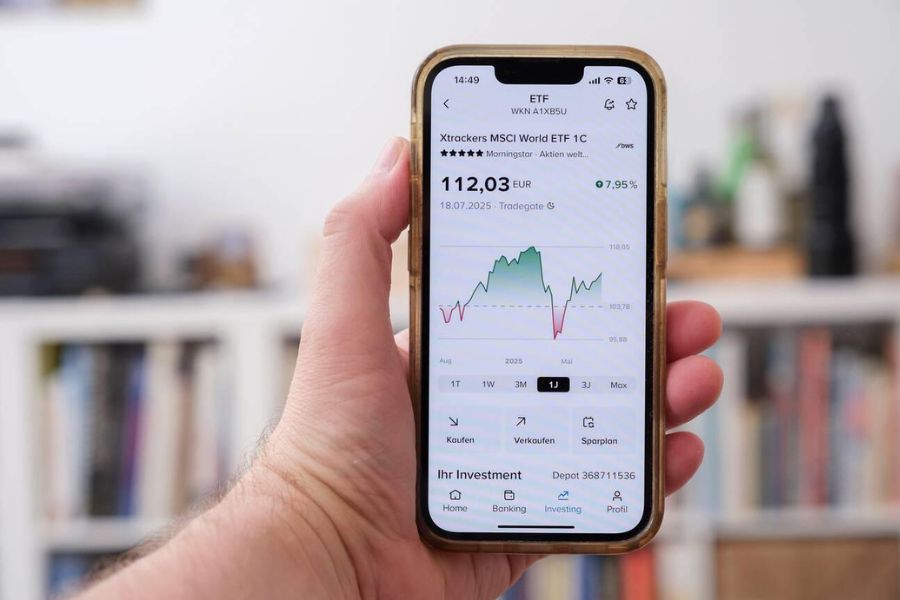Most folks assume you need fancy strategies or endless research to outsmart professional investors. But honestly, that’s just not true. What if I said you could set up a killer portfolio in just 15 minutes a year, and it’ll beat 90% of the pros? I’m not kidding—this approach uses low-cost index funds to track the whole market. You end up with better returns than most money managers, and you pay a tiny fraction of the fees those big mutual funds charge.

Fund managers rarely beat the market for long. Instead of hunting for the next big winner, you just own the entire market and let time and compound growth work their magic. I’ve watched too many investors throw away thousands on complicated portfolios with a dozen funds. In the end, they often trail behind a simple three-fund setup. The magic here is in keeping things easy. You’re not trying to outwit Wall Street—you’re just riding along with the market.
With a few broad index funds for stocks and bonds, you get instant diversification and crazy-low costs. Over a lifetime, that can mean saving hundreds of thousands of dollars.
Key Takeaways
- A no-fuss portfolio of cheap index funds beats 90% of pros, and you only need 15 minutes a year to keep it running.
- Swapping high-fee funds (2%+) for broad index funds with fees near 0.05% could save you a fortune over time.
- You can build a solid portfolio with just 3–4 index funds. Cover U.S. stocks, international stocks, and bonds—adjust for your age and risk comfort.
What Is the 15-Minute Portfolio and Why Does It Work?
The 15-minute portfolio is all about simple index funds and a bit of automation. You end up beating most professional investors by keeping costs low and staying consistent. This strategy takes the emotion out and ditches all those tricky decisions that usually eat into your returns.
Performance Versus Professional Investors
Most active fund managers can’t keep up with the stock market over the long haul. Seriously, studies show 90% of them fall behind basic market indexes after 10 years.
Fees eat up a huge chunk of your money. Active investing often charges 1–2% per year, while my 15-minute approach costs just 0.03–0.1% annually.
Here’s what that means for your wallet:
| Investment Type | Annual Fee | Cost on $100,000 | 20-Year Impact |
|---|---|---|---|
| Active Fund | 1.5% | $1,500 | $52,000 lost |
| Index Fund | 0.05% | $50 | $1,700 lost |
Pros also mess up their timing. They buy high when the market’s hot and panic-sell when it drops. My automated system skips those mistakes.
Numbers don’t lie—keeping it simple wins in investing.
Market Indexes and Passive Investing
Index funds let you own hundreds or even thousands of stocks in one swoop. Buy something like VTI, and you’ve got a tiny piece of the entire U.S. market. This gives you instant diversification. If one company tanks, you still own thousands more. Over the last century, the stock market has grown about 10% a year.

Index funds don’t try to beat the market—they just follow it. This passive style is cheaper and, honestly, works better than most active investing.
Some favorites:
- VTI: Total U.S. stock market
- VOO: 500 largest U.S. companies
- VT: Global stock market
When good companies grow, your portfolio grows. If a company fails, it just drops out and a stronger one takes its place.
The Power of Systematic Simplicity
The 15-minute portfolio shines because it takes human error out of investing. Most people buy when stocks are expensive and sell when they’re cheap.
Automation fixes that. You invest the same amount each month, no matter what the headlines say. This is called dollar-cost averaging.
Setting up automatic deposits takes no time at all. After that, your main job is to leave the system alone.
Simple beats complicated—especially in investing. You don’t need to chase stocks, time the market, or obsess over financial news. The system handles it.
This approach is way less stressful. No more losing sleep over market swings or second-guessing your choices.
Emotions wreck investment returns. My system keeps fear and greed out of the picture.
Core Components: Building the 15-Minute Portfolio
To build a winning 15-minute portfolio, I pick low-cost index funds and ETFs, keep things diversified, and make sure fees stay low. These parts work together to create a straightforward but powerful investment strategy.
Choosing the Right Index Funds and ETFs
I stick to broad market index funds and ETFs that track major indices. One fund gets me hundreds or thousands of companies.

Top Index Fund Categories:
- Total stock market funds (cover the whole U.S. market)
- S&P 500 index funds (biggest 500 U.S. companies)
- International developed market funds
- Emerging market funds
- Total bond market funds
ETFs let you trade during the day, unlike mutual funds. Vanguard, Fidelity, and Schwab usually have the lowest fees.
I skip actively managed funds—they rarely beat index funds in the long run. Data shows 90% of active funds lag behind their benchmarks after 15 years.
Essential Asset Classes and Allocation
How I split up my portfolio depends on age and risk tolerance. I use three basics: U.S. stocks, international stocks, and bonds.
Sample Asset Allocation by Age:
| Age Range | U.S. Stocks | International Stocks | Bonds |
|---|---|---|---|
| 20-30 | 50% | 30% | 20% |
| 30-40 | 45% | 25% | 30% |
| 40-50 | 40% | 20% | 40% |
| 50+ | 35% | 15% | 50% |
Stocks offer growth but can swing wildly. Bonds are steadier but don’t grow as fast.
International stocks help smooth things out when the U.S. market takes a hit. I usually keep 20–30% of my stock money overseas.
Diversification for Risk Reduction
Diversification keeps me from putting all my eggs in one basket. I spread money across different companies, countries, and sectors.
Index funds come with built-in diversification. A total stock market fund holds thousands of companies in every sector.
I avoid overlapping funds. If I own both an S&P 500 fund and a total market fund, I’m just doubling up on big companies.
Diversification Rules I Follow:
- No single stock is more than 5% of my portfolio.
- I mix growth and value stocks.
- I include big, medium, and small companies.
- I balance U.S. and international exposure.
Spreading investments globally helps when one country’s market stumbles. Currency swings add another layer of protection.
Expense Ratios and Investment Fees
Investment fees are sneaky—they eat into your returns year after year. Just 1% extra in fees can cost you hundreds of thousands over a few decades.

I aim for expense ratios under 0.20% for all my index funds and ETFs. Plenty of solid choices charge only 0.03% to 0.10% a year.
Fee Comparison:
- Low-cost index funds: 0.03%–0.10%
- Average mutual funds: 0.50%–1.00%
- Active funds: 0.75%–2.00%
Some mutual funds tack on extra charges like load fees or marketing fees. I dodge these by picking no-load index funds.
ETFs generally cost less than mutual funds and don’t charge redemption fees when I sell.
I check my statements now and then to make sure I’m not getting hit with hidden charges. Some brokers sneak in transaction fees for certain funds.
Tailoring the Portfolio to Your Life and Goals
Your 15-minute portfolio works best when it fits your unique situation and investment goals. The trick is to tweak your allocations for your retirement timeline, risk comfort, and account types.
Setting Financial and Retirement Objectives
I always suggest starting with a real number for your financial goals. Don’t just aim for “enough money”—figure out the actual dollar amount you’ll need.
Quick formula for your retirement nest egg:
- Annual retirement expenses × 25 = Target nest egg
- So, if you’ll spend $60,000 a year, you’ll need $1.5 million.
Tie your investment goals to milestones. I like setting targets for ages 30, 40, 50, and retirement.
Common savings goals by age:
- Age 30: 1x your annual salary saved
- Age 40: 3x salary
- Age 50: 6x salary
- Retirement: 10–12x salary
If you need money soon (within 5 years), use cash or bonds—not stocks. Emergency funds and short-term expenses don’t belong in the market.
Risk Tolerance and Time Horizon Considerations
Your time horizon shapes how much risk you should take. I use a simple rule: 120 minus your age equals your stock percentage.

A 30-year-old might have 90% in stocks, but a 60-year-old could dial that back to 60%. It’s not perfect, but it’s a solid starting point.
Risk tolerance isn’t just about age:
- Conservative: Lose sleep over a 10% drop? Go safer.
- Moderate: Okay with 20% swings? You’ve got options.
- Aggressive: Fine with 30%+ drops? Go for more stocks.
Your job and income matter too. If you have a steady paycheck or a pension, you can take more risk than someone with irregular income.
I adjust the basic portfolio by nudging stock allocation up or down 10–20%, based on comfort.
Adjusting for Major Accounts: IRA, RESP, and More
Different accounts need different strategies. In your IRA, focus on investments that generate the most taxes, since the account shelters you.
Account-specific tips:
- Traditional IRA: Load it up with bonds and REITs.
- Roth IRA: Put your highest-growth picks here.
- Taxable accounts: Stick to tax-efficient index funds.
- RESP: Get more conservative as college nears.
I like using my IRA for the bond part of my portfolio. That way, I can rebalance without worrying about taxes.
For RESP accounts, start aggressive when the kids are young, then shift to safer stuff 5–7 years before college. A 10-year-old’s RESP might be 70% stocks, but by age 16, I’d drop that to 30%.
Make sure your whole portfolio—across all accounts—matches your target allocation. Don’t treat each account as its own island.
Maintaining, Managing, and Growing Your Portfolio
Keeping your portfolio on track is easier than people think. With a system, you can manage everything in just 15 minutes a year.
Annual Rebalancing in Under 15 Minutes
I block out 15 minutes once a year to rebalance. It’s quick and keeps my investments lined up with my plan.
Markets move, and your balance drifts. Maybe you start with 60% stocks and 40% bonds, but a hot stock market pushes you to 70/30.
My 15-minute rebalancing steps:
- Check where your allocations stand.
- Compare them to your targets.
- Sell what’s overweight.
- Buy what’s underweight.
I use a basic spreadsheet to track it. If stocks jump from 60% to 70%, I sell some stock funds and buy more bonds to get back to 60/40.
How often should you rebalance? Yearly works best for most people. Monthly is overkill and racks up trading fees. Waiting two years might let things drift too far.
This habit forces me to sell high and buy low without thinking about it. When U.S. stocks soar, I pocket some gains and move money into bonds or international stocks.
Staying Accountable During Market Volatility
Market volatility? It really puts your discipline to the test. Over the years, I’ve realized that keeping calm during those wild swings is honestly one of the most important things for long-term investing.

Here are my go-to volatility management rules:
- I don’t check my portfolio every day when things get rough.
- I keep 3-6 months of expenses in cash, just in case.
- When markets are quiet, I write down my investment plan.
- During downturns, I pull out that written plan and actually read it.
If the market drops 20% or more, I remind myself—this happens. The S&P 500 has bounced back from every single major decline in history. That’s pretty reassuring, isn’t it?
I tune out financial news during big market moves. Most news outlets just want to stir up fear or excitement, not help me make better decisions.
Accountability partners make a difference. Every year, I sit down with my spouse and talk through my investing strategy. Having someone else in the loop keeps me from making emotional moves.
In 2022, when the market took a nosedive, I stuck to my rebalancing routine. I actually bought more stocks while they were cheaper, and that paid off when things rebounded in 2023.
Evaluating New Products and Making Smart Investment Decisions
New investment products pop up all the time. Before I add anything to my simple portfolio, I take a close look.
Here’s my quick checklist for evaluating new products:
- Does it fill a real gap in my current allocation?
- Are the fees lower than what I already pay?
- Has it been around for at least three years?
- Do I genuinely understand how it works?
Most new products don’t make the cut. Complex ones usually charge more and rarely boost returns. I stick with broad market index funds—they’ve got the track record.
If I spot a new total stock market fund with fees that are 0.05% lower than my current option, I might switch. Those tiny fee differences add up big time over the years.
I dig into fund company websites and places like Morningstar for research. I never buy something just because it performed well recently.
Whenever I add a new investment, I make sure to remove something else. Keeping my portfolio simple helps me avoid overlap and confusion.
Patience beats speed every time. I always give myself at least a month to research before I make any portfolio changes.
Frequently Asked Questions
People ask a lot about simple investment strategies—how to put them into practice, how they actually perform. The best portfolios usually stick to low costs, broad diversification, and passive management that doesn’t need much maintenance.
What Strategies Do Top Performing Portfolios Employ to Outperform the Market?
Top portfolios keep costs super low. I’ve noticed the best ones use index funds or ETFs with expense ratios under 0.5% per year.
They don’t try to time the market or pick hot stocks. Instead, they invest in broad market indices and let the whole market do the work.
Regular rebalancing is huge. I suggest checking your portfolio once or twice a year to keep your target allocation in line.
The most effective portfolios are simple. Warren Buffett’s famous 90/10 mix? Just two funds—90% stock market index, 10% short-term bonds. Simple, but it works.
How Can Diversification Impact Your Investment Success?
Diversification spreads out your risk, so you don’t have to sacrifice returns. If one part of your portfolio struggles, something else can pick up the slack.
A solid portfolio mixes domestic stocks, international stocks, and bonds. This way, you’re not tied to any one country’s economy or a single sector.
Geographic diversification matters more than people think. International investments help you avoid overreliance on one country.
Even a basic three-fund portfolio gives you great diversification. Just use a total stock market fund, an international fund, and a bond fund.
What Are the Key Components of a High-Yield, Low-Maintenance Investment Portfolio?
Start with low-cost index funds or ETFs. You don’t need to research every stock or make constant trades.
A simple portfolio only needs three or four funds at most. More than that just adds complexity without much benefit.
Automatic investing and rebalancing make things easier. Set up monthly contributions and plan to rebalance once a year—it shouldn’t take more than 15 minutes.
Go for broad market funds, not sector-specific ones. Total market funds give you exposure to thousands of companies with one click.
Why Should You Consider Time Horizon When Building an Investment Portfolio?
Your time horizon tells you how much risk you can handle. If you’ve got decades, you can ride out downturns and benefit from compounding.
If retirement is far off, you can hold more stocks. The old rule says your bond percentage should roughly match your age.
Shorter timeframes mean you need to be more conservative. Money you’ll need in five years or less? Keep it in bonds or cash.
Younger investors can stomach more ups and downs. More time means more chances to recover from crashes—and higher long-term returns.
How Do Professional Investors Allocate Assets in Successful Portfolios?
Professionals usually set target percentages for stocks, bonds, and other assets based on long-term goals. That’s strategic asset allocation in action.
The classic 60/40 split—60% stocks, 40% bonds—still shows up in a lot of professional portfolios. It balances growth and limits risk.
Younger investors often get higher stock allocations. A 30-year-old might go 70% stocks, 30% bonds.
As people get closer to retirement, they shift to more bonds—maybe 40% stocks, 60% bonds—to protect against big losses.
What Are the Risks and Rewards of Active vs. Passive Investment Strategies?
Active investing is all about trying to beat the market. People do this by picking stocks and timing their trades.
But here’s the thing—less than 10% of professional fund managers actually outperform the big market indices year after year. That number always surprises me.
You’ll also notice that active strategies tend to cost way more in fees. We’re talking 1-2% every year, while some index funds only ask for about 0.1%. That difference adds up fast.
Passive investing, on the other hand, just accepts whatever the market gives you. No fancy moves, no stress. And honestly? This approach outperforms about 90% of active strategies over the long haul.
What’s the catch with passive investing? Well, you’re never going to beat the market. But you won’t fall way behind either, and that’s a comfort for a lot of folks.
Active investing dangles the possibility of higher returns. But wow, the risk of losing out is much higher too.
If you ask me, most people would probably come out ahead by sticking with passive strategies.



